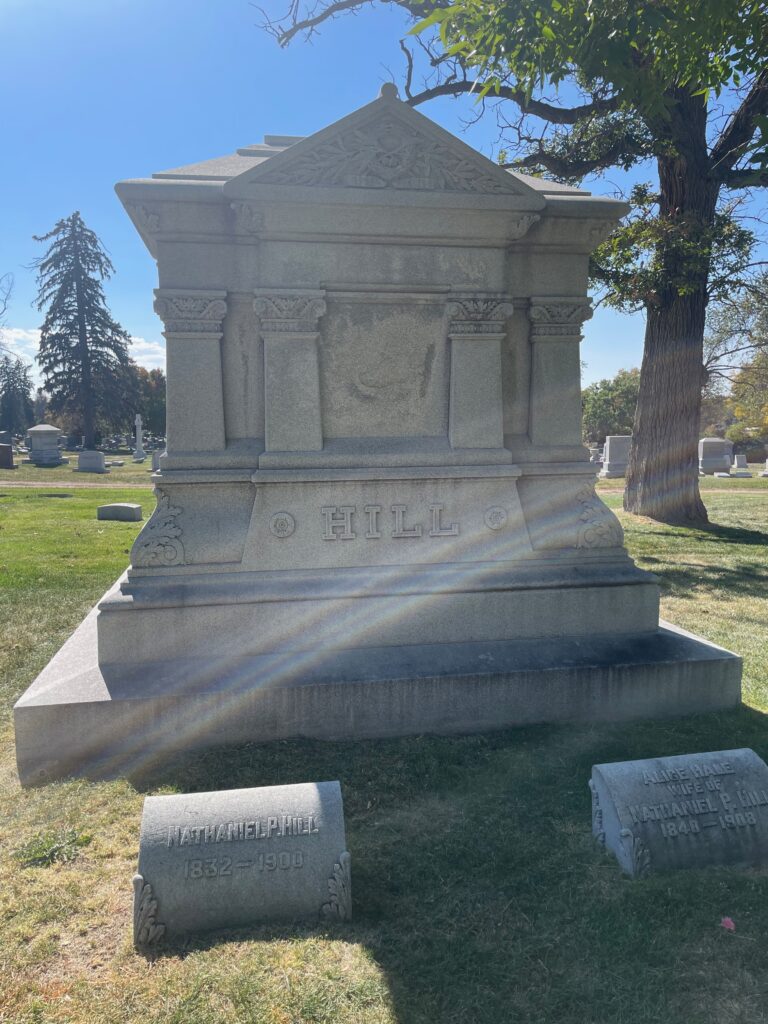Erik Visits an American Grave, Part 1,866
This is the grave of Nathaniel Hill.

Born in 1832 in Montgomery, New York, Hill grew up on a farm, but pretty well off. His older brother went to Yale, but Nathaniel had to settle for Brown. The horror. He graduated from there in 1856 and soon was teaching chemistry at the school. He pushed to build modern laboratories at Brown, which was a new idea coming over from Europe.
But Hill was young and wanted some adventure that combined his science with some fun. So when he was asked to go to Colorado to use his scientific expertise in mining, that sounded good to him. A cotton capitalist named William Reynolds was funding this in 1864 (I think the guy might have been more of a mill owner given that this is the middle of the Civil War, but that’s how he’s described). Hill joined. The trip was a disaster. They found nothing. But Hill caught gold fever. He sold everything he owned back in Providence and went back to Colorado to find the color.
At first, it didn’t go well for Hill. He bought a bunch of mines that did nothing. Finally, he got some sense behind him and started looking at smelting techniques, where one could actually make money. The problem was that the smelting techniques in Colorado at the time were extremely rudimentary. So Hill decided to go to England to study the problem, bring back more modern technologies, and then invest in them in the West. He ran across what was known as the Swansea process on the trip, using copper sulfide ore that would separate out gold and silver from other rock. He brought that back to Colorado, settled in the mining town of Black Hawk, and proceeded to make his fortune. He founded the Boston & Colorado Smelting Company, a name that reflected his investors as well.
It did not take Hill long to go into politics after getting rich. He first became mayor of Black Hawk in 1871. Well, whatever. But he soon moved to Denver to live in what passed for the Colorado elite of that time. So in 1879, Colorado Republicans decided to send Hill to Washington as a senator. He was a good representation of that type of Republican–one with very strong western characteristics. Presaging the Populist movement, Hill was pro-silver and anti-monopoly. Being a Republican in Colorado at this time was basically a necessity in order to compete in the waving a bloody shirt era, but Colorado Republicans were generally a lot different than those in, say, Ohio, and a lot more of them would eventually find their way over to the Populists and often then the Democrats.
Hill only had one term as senator and it wasn’t tremendously exciting. Mostly, he ranted against monopolies, undoubtedly to the annoyance of his colleagues openly in the pocket of monopoly capitalists. On the other hand, politicians of this era had an amazing ability to rant against the very thing they were while seeing no contradictions. But when he came up for reelection in 1885, Colorado sent Henry Teller in his place, who was actually pretty similar on a lot of policies and who would be one of those Republicans migrating to the Populists and then Democrats. I’m not really sure why Colorado went for Teller over Hill given that.
After he left the Senate, Hill bought a newspaper in Denver and used it as his personal mouthpiece. He did a ton of real estate dealings and of course had his smelter operations. Money was not a concern. He died in 1900, of some stomach aliment. He was 68 years old.
Nathaniel Hill is buried in Fairmount Cemetery, Denver, Colorado.
If you would like this series to visit other senators elected in the 1878-79 cycle, you can donate to cover the required expenses here. J. Donald Cameron is in Harrisburg, Pennsylvania and John Logan, who represented Illinois, is in Washington, D.C. Previous posts in this series are archived here and here.


